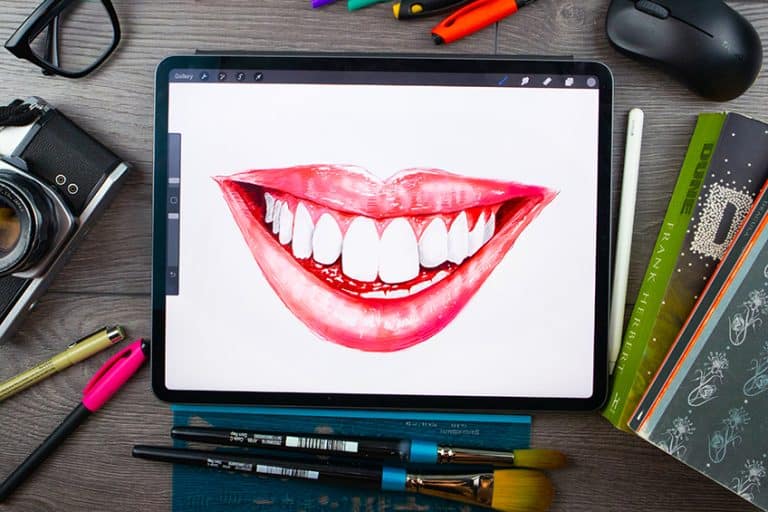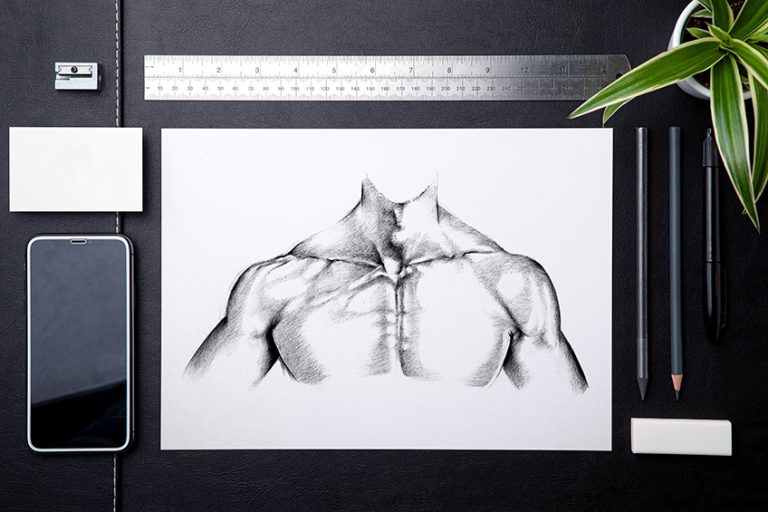How to Draw a Man – Mastering the Basic Proportions
Learning how to draw men is a great exercise that can help you understand the male torso. A drawing of a man can be done in a variety of ways, given that there are many different body types. With the male figure, we see that men can shift in body type, from lean to heavy, which changes the entire aesthetic of a man’s body. With that being said, this gives us a great deal of options when it comes to character design and representing different figures within an artwork. Understanding how to draw a man is useful for understanding the anatomy of a body and how it can be represented in different forms. There is a lot to learn from an easy man drawing, making it useful for a variety of reasons.
Step-by-Step Guide to Drawing a Man
This will help us understand how the frame of the male figure is formed within its various segments. From there we will create different body types around this frame, looking at body types from lean to muscular and finally to heavy. This will give us an understanding of proportions, and how to change them to suit different body types. Now that we know what to expect, let’s go through the breakdown of a drawing of a man.

In this tutorial on how to draw a man, we will break down the process into simple easy-to-follow steps, starting with the fundamentals of the male figure.
Understanding the Basic Proportions and Frame of a Man
Male figures come in all shapes and sizes, and to understand how to represent the male figure in various ways, we need to first understand basic proportions.

The male figure is of eight equal segments that divide the body into different parts. These eight equal segments define the placement of the different body parts. This is true for all figure proportions and sets the foundation for understanding how to represent different physiques within these correct proportions.
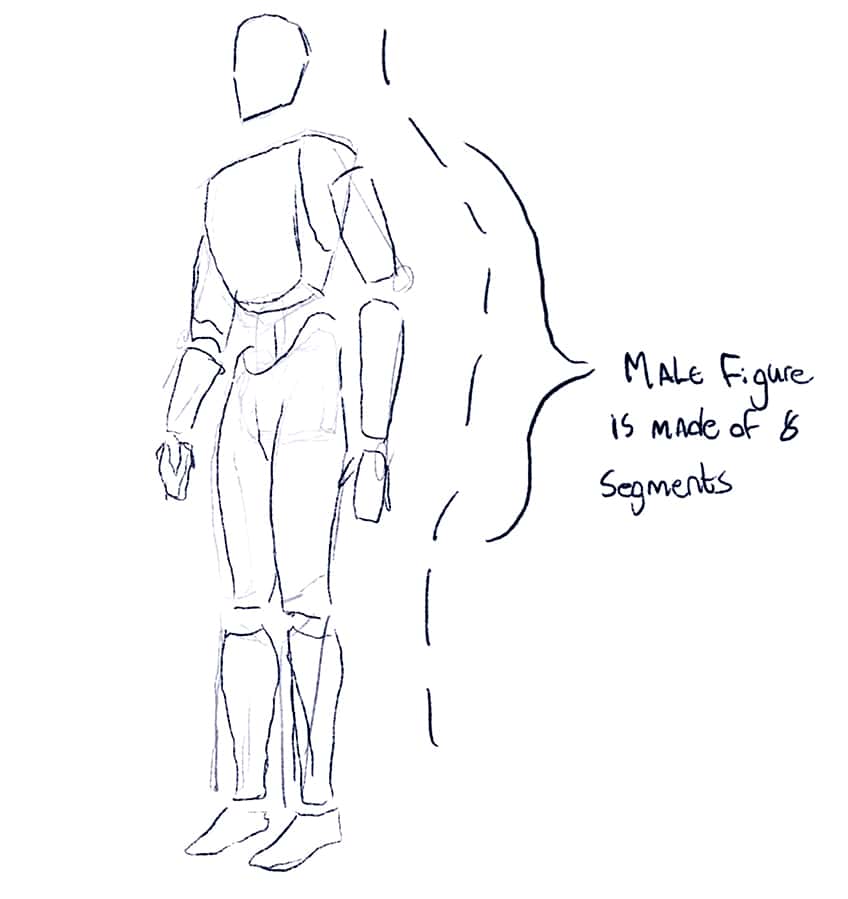
The fourth segment generally determines the position of the pelvic bone, which is the point that evenly divides the body into two parts. In a more simplified sketch, we can see how to determine the position of various features within their corresponding segments.
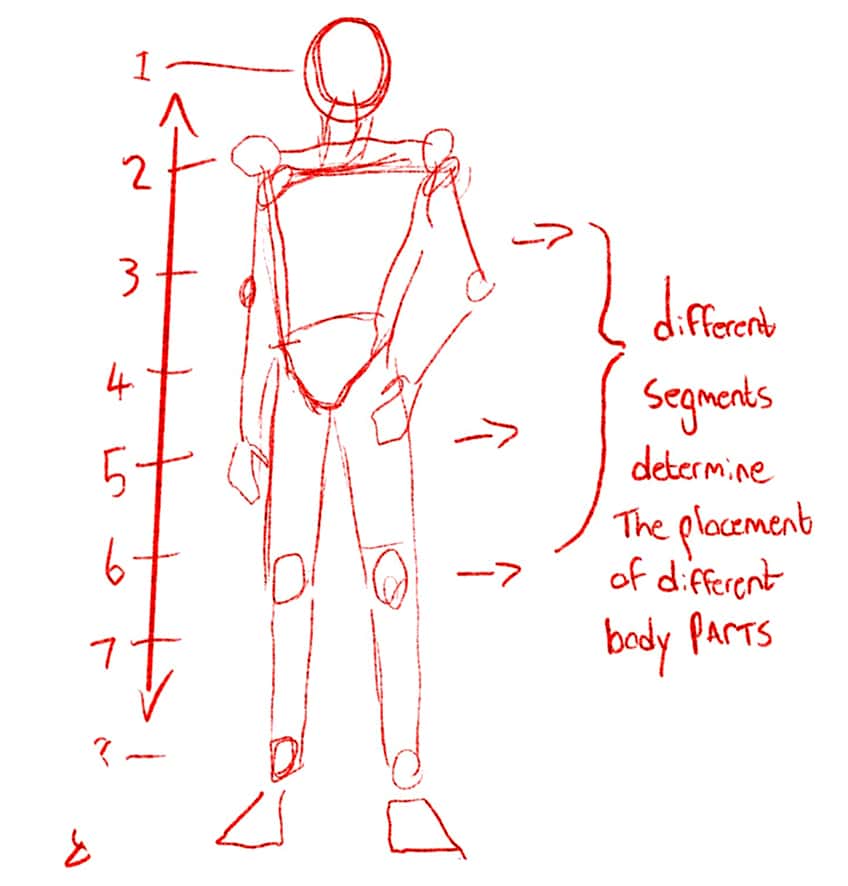
Making sure we position the pelvic bone along the middle area or fourth segment, will generally be a good indication for determining the placement of different features.
Utilizing a Skeletal Structure to Draw a Man
Once we know the basic proportions for how to draw men, we can then proceed to start forming figures with a basic skeletal structure to determine their unique length and body type. The intention is to always start with a simple skeletal drawing to determine the length of different body parts and to capture the proportions correctly.
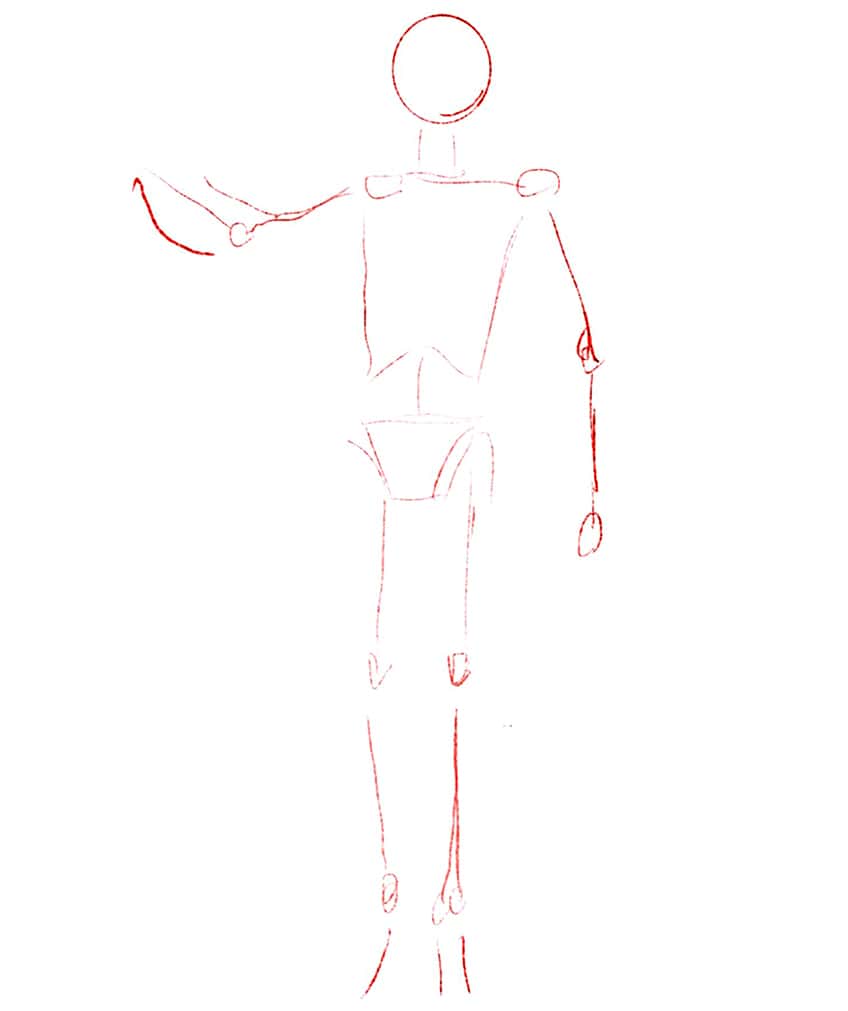
Using the skeletal structure will enable us to shape the character around it to form a more easy man drawing process.
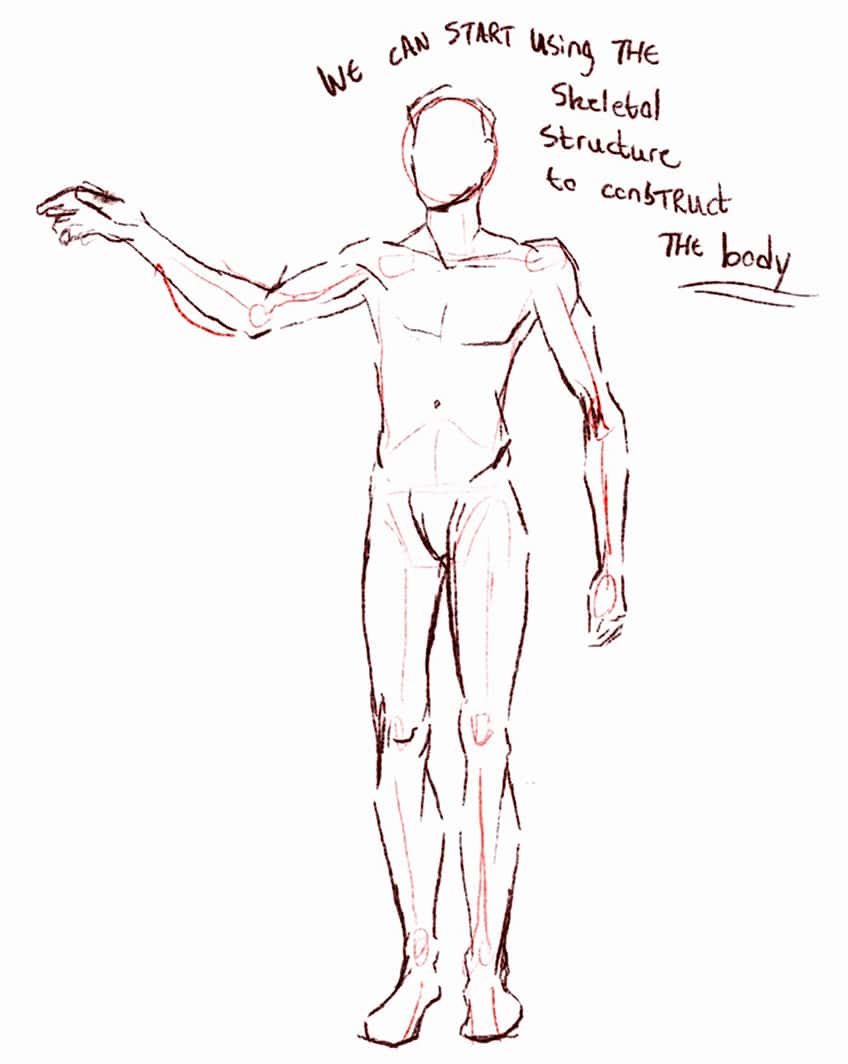
Already, we can start considering the shape of the body parts, how muscular or fat a figure should be, and other unique bodily features.
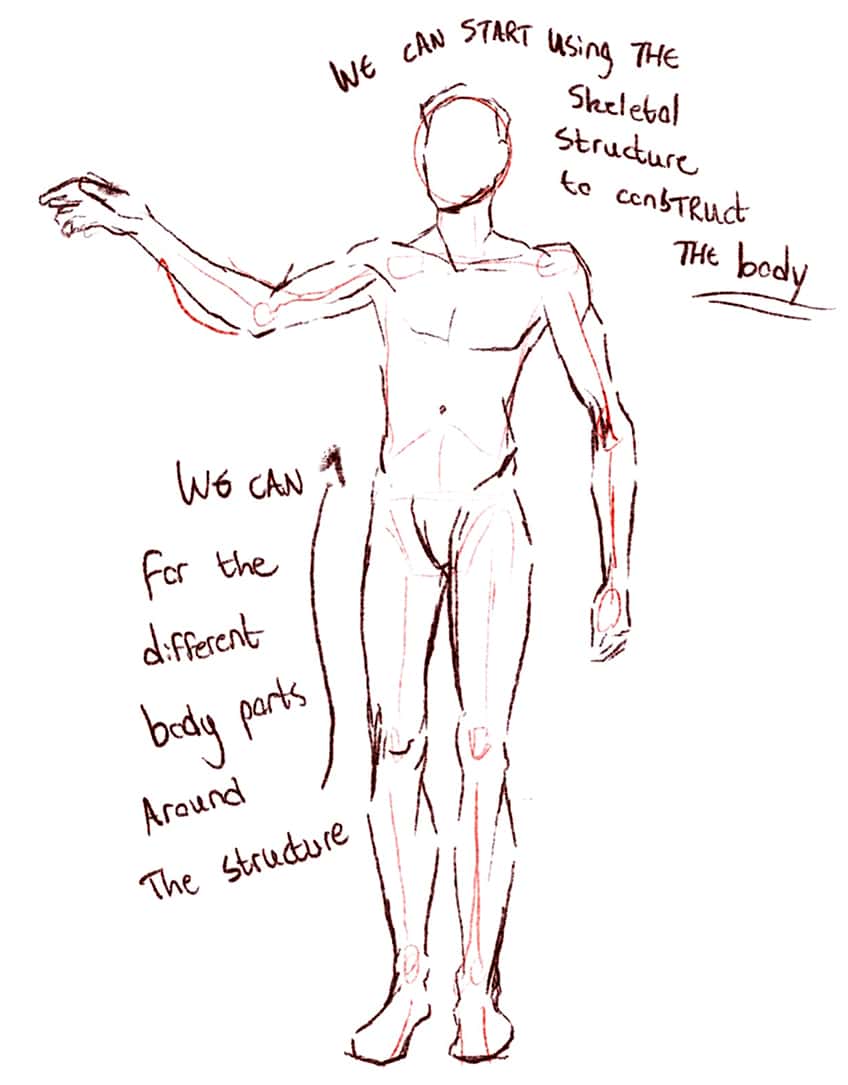
This can also allow us to break down unique poses and see how the body shape of a man is constructed in a drawing.

As we form the man with this process, we can easily get comfortable with defining subtle details such as narrowness in the hips or broader shoulders and so on.
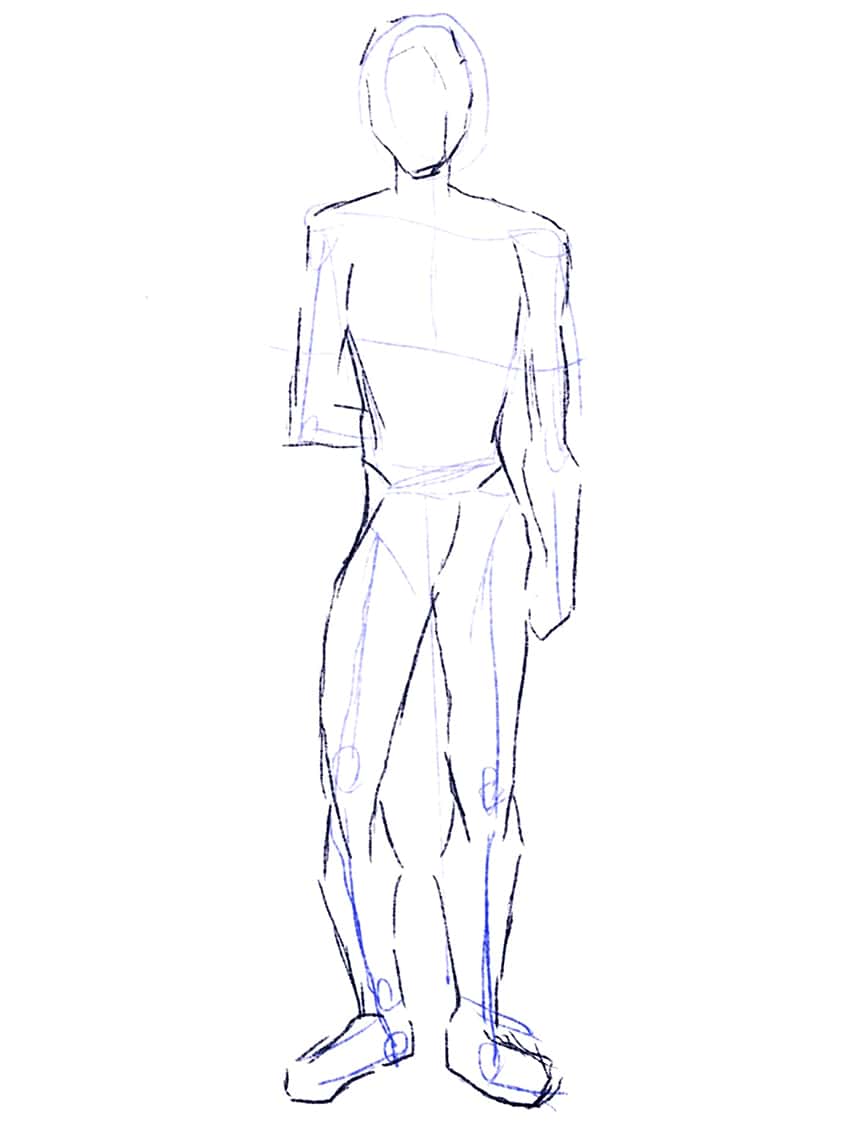
The skeletal structure allows us to shape the general outline around the figure more effortlessly and therefore explore basic bodily shapes.
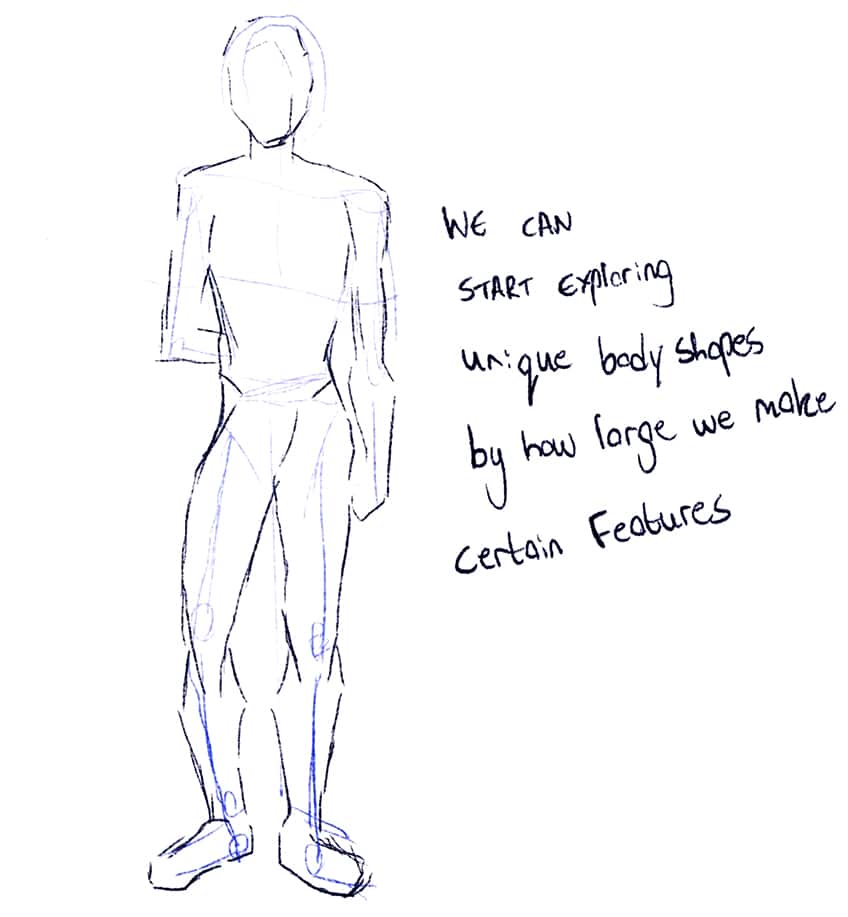
As we do this, we can start exploring unique details, such as enlarging the head or making the shoulders slightly wide, all of which can be a unique trait of the character design. We can consider all these details from head to toe, slowly forming a figure of a man with a specific body physique.

Starting with simple physiques is a great way to also get comfortable with this process before representing more unique physiques with this process.
Drawing a Lean Physique
The more comfortable we get with the basic formation of the skeletal structure and proportions, we can create unique physiques such as lean muscular physiques. For instance, in the case of a more lean physique, we can keep the features quite narrow throughout the figure, with a larger head. We can define the muscles distinctly, but the idea is to keep these various features narrower to suggest a leaner physique. This means we can keep the physique formed quite closely around the skeletal structure of the man.

In doing so we can see how this can be used for more sporty characters or characters in a drawing of a man.
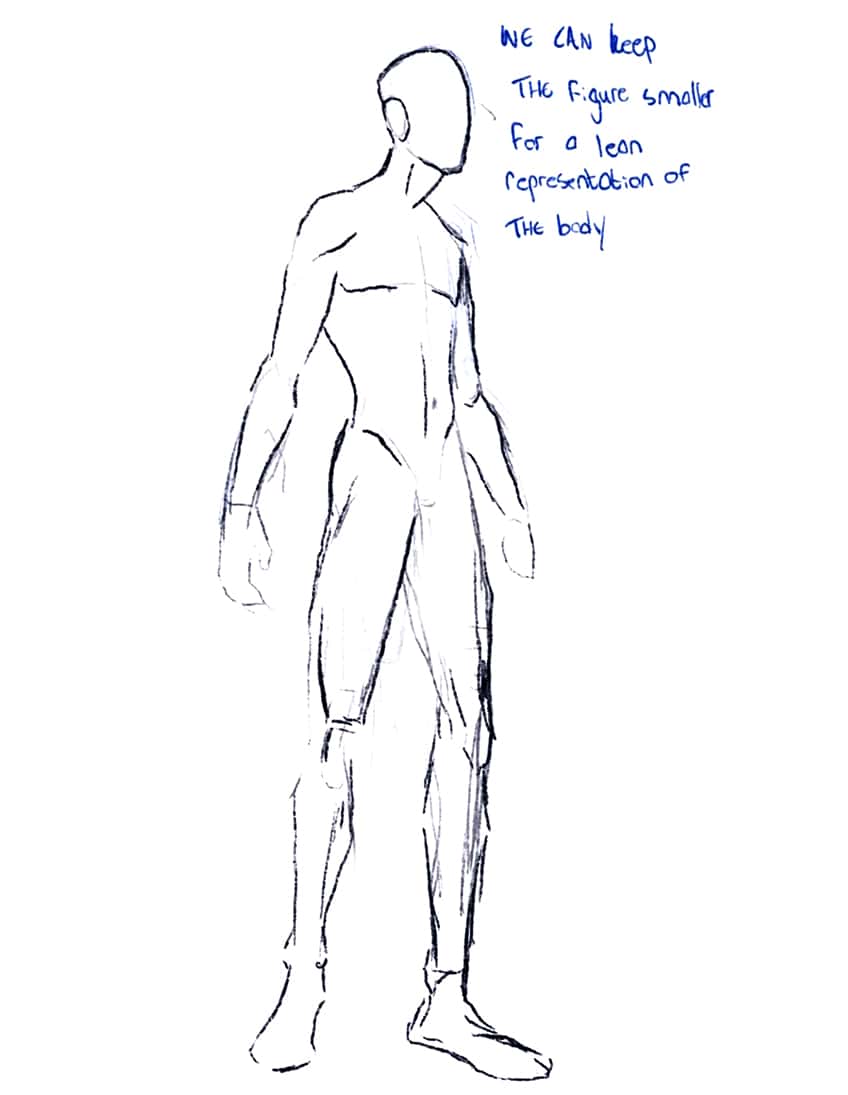
Drawing a Muscular Physique
As you learn how to draw men, the torso of a large part is often definitive of how the rest of the body will look.

Once again, we want to establish the skeletal structure and basic shapes of the figure, but if we want a more defined muscular physique, we can start to be more distinct with our lines.
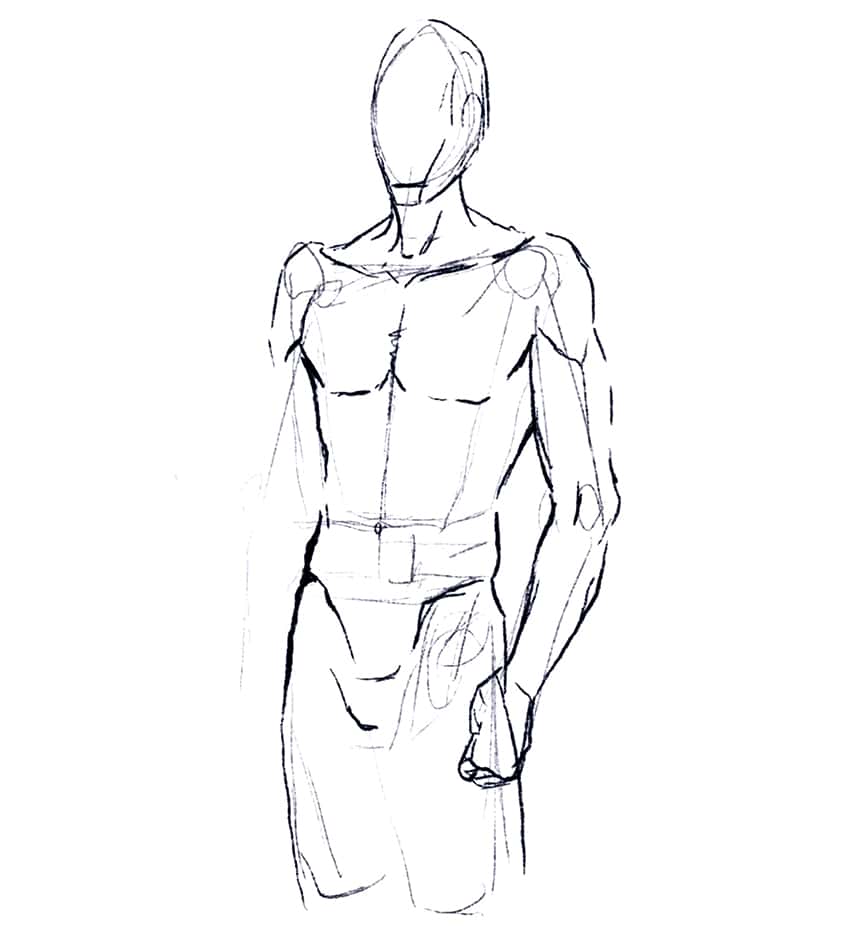
This is where we can utilize linework to emphasize the different muscles present within the male physique, such as the chest and abdominal muscles.

In doing so, this can help us determine how muscular we want the legs to be or how muscular we want the arms to be. Generally, we want there to be consistency within the various body parts.

Slowly, we can build up shading and tonal values to emphasize the features of the physique of a more classical muscular man.

Drawing a Heavy Man
In the case of larger men who are more heavy, we follow the sample formation process of the basic shapes and skeletal structure. However, this time we want to think about roundness within the different bodily features and how it defines a heavier physique.
We want to maintain this quality throughout all the features to have consistency within the physique. We can make some areas more narrow or thinner, to explore more quirky shapes in the character.

As we continue to define a more heavy figure, we want to consider how all areas of the body compensate for the large figure.
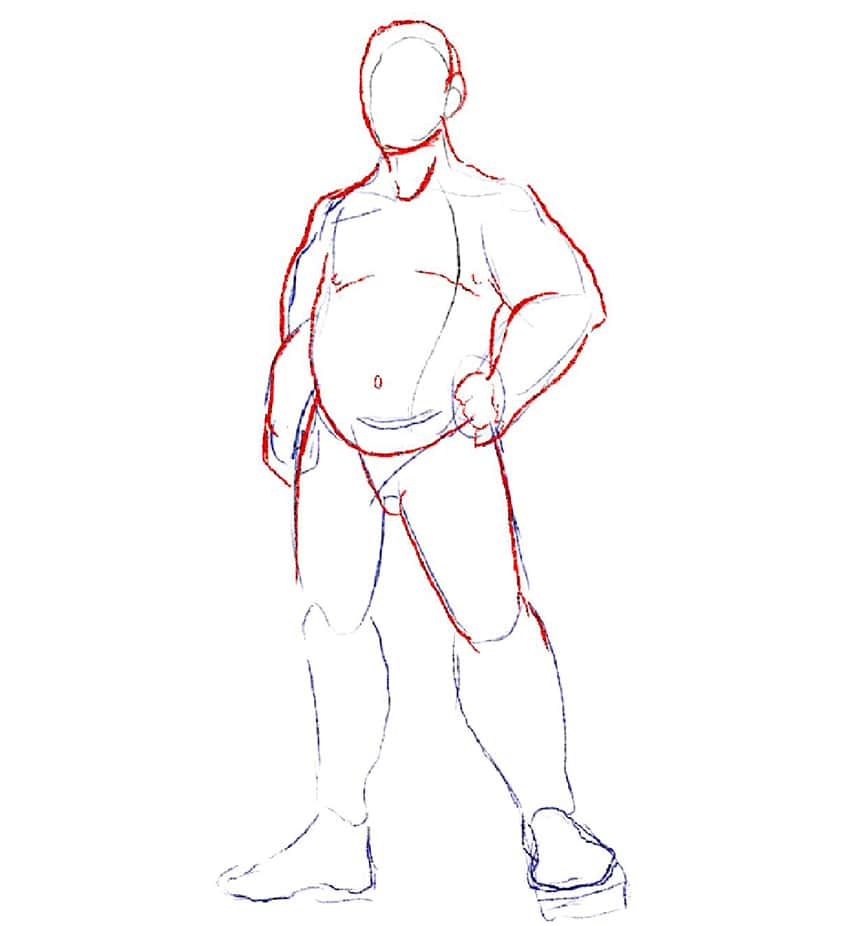
What is meant by this is that the legs should make sense in proportion and how they are large enough to stabilize the body, in this case, we can make the legs slightly rounded as well.
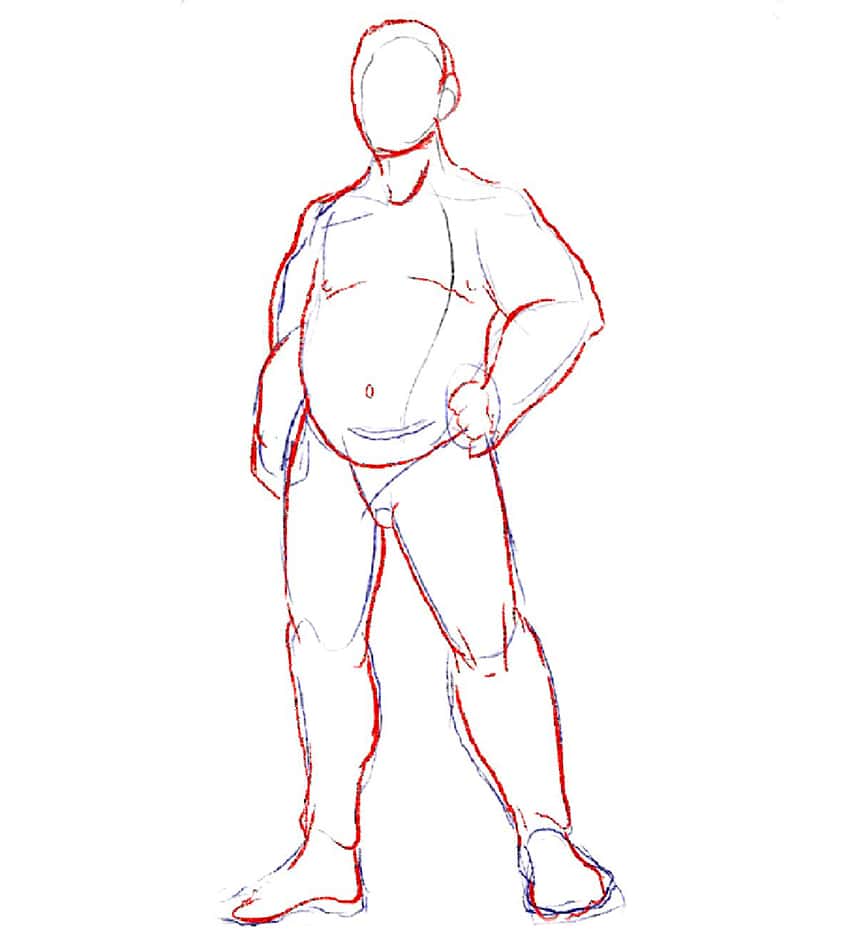
Again, it is a matter of stylistic intentions, but the idea for a more natural and realistic heavy figure is to maintain consistency in the shape of all the features.
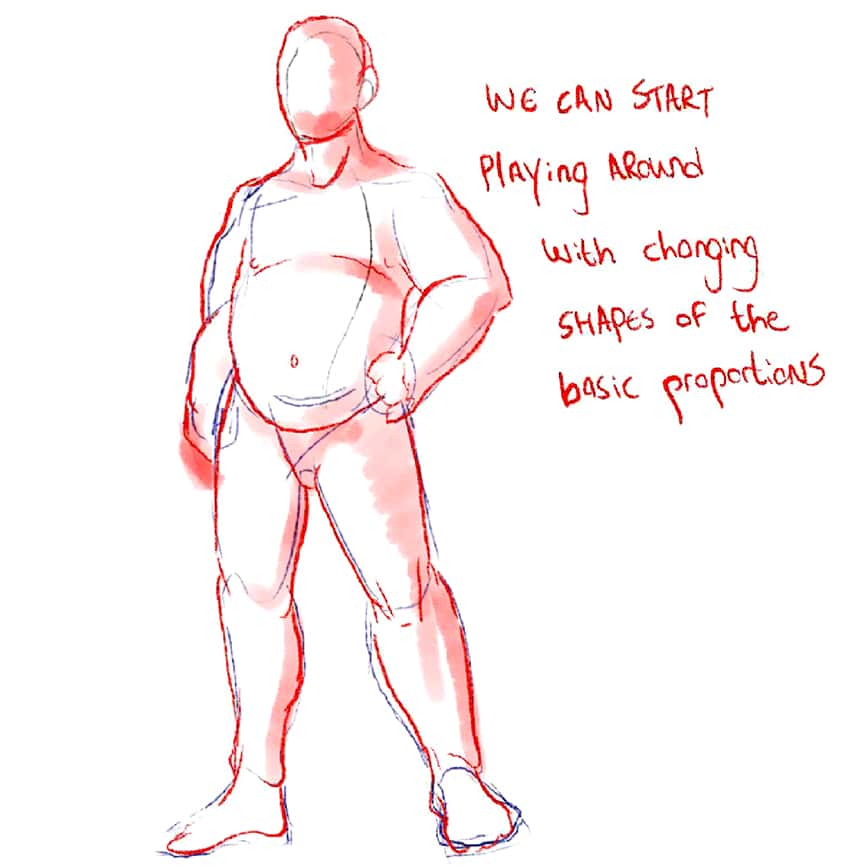
Utilizing Shadows and Light in a Drawing of a Man
The male figure is made of various muscles and bones that cause protrusions and indentations within the body. We want to know how the muscles and bones create these defined structures within the body and cause shadow formations.

As we get more comfortable with proportion and frame, we can start becoming more intentional with the anatomy and how shadows form along the surface area of the skin.

Again, the intention is to always start simple with linework, which determines the placement of shadows along the physique.

This is where our awareness of the rounded qualities in the abdominal muscles will cause protrusions and subtle shadow formations along the surface area of the body.

We also want to think about how the muscles are more rounded and subtle protrusions, whereas bones create more harsh geometric protrusions in the body. Taking our time, we can slowly build up these shadow formations present within the body of the figure.
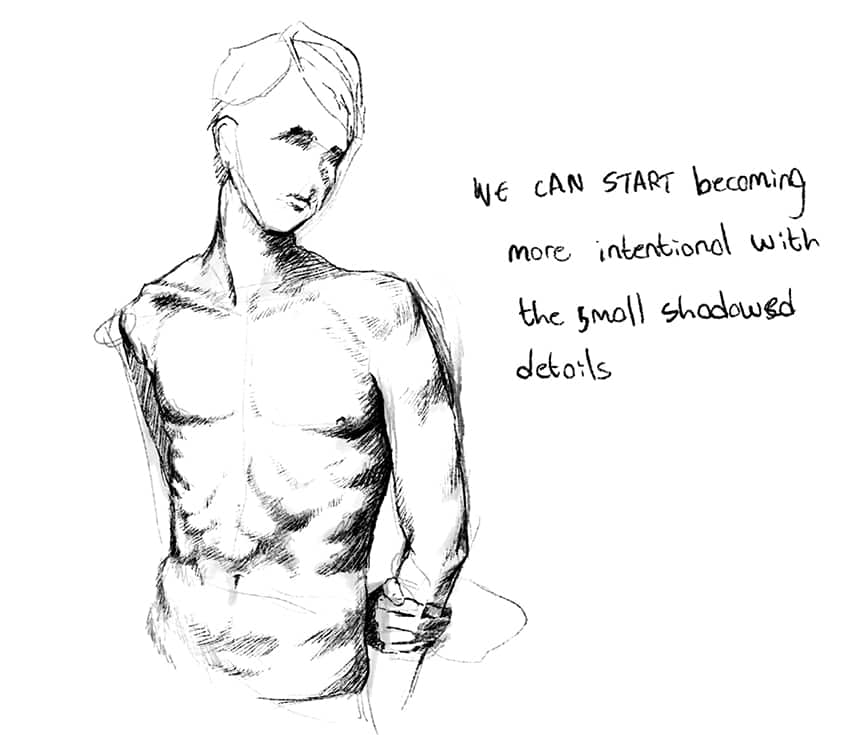
As we become more comfortable with the male figure proportions, we can become more specific with how we define the features with shadow formations.

Most importantly, take your time working with basic line formation to determine the placement of the shadows. From there you can build them up through layers of different tonal values.

Tips and Tricks to Remember
- First, understand the fundamentals of proportions. Know the position and scale of different body parts according to the eight segments as you establish the man sketch.
- Build up the figure around the frame. Once you know the scale of the body parts, start with a simple skeletal structure and build the character around it.
- Work with layers as you construct the figure. The idea is to always build the man sketch with layers, from outline all the way to shading.
- Explore different physiques. Learning how to draw a guy requires you to explore various body types.
- Consider a light source for your shading. We always want to make the shadow formations form along one side of the body for a more accurate representation of light.

As you learn how to draw a man, we see that the process becomes quite easy once we know the fundamental proportions. A male torso remains the same in proportions, however, the body shape slightly changes to define different body types. As we draw the body around the frame, we see it is quite easy to define different body types.
Matthew Matthysen is an educated multidisciplinary artist and illustrator. He successfully completed his art degree at the University of Witwatersrand in South Africa, majoring in art history and contemporary drawing. The focus of his thesis was to explore the philosophical implications of the macro and micro-universe on the human experience. Matthew uses diverse media, such as written and hands-on components, to explore various approaches that are on the border between philosophy and science.
Matthew organized various exhibitions before and during his years as a student and is still passionate about doing so today. He currently works as a freelance artist and writer in various fields. He also has a permanent position at a renowned online gallery (ArtGazette) where he produces various works on commission. As a freelance artist, he creates several series and successfully sells them to galleries and collectors. He loves to use his work and skills in various fields of interest.
Matthew has been creating drawing and painting tutorials since the relaunch in 2020. Through his involvement with artincontext.org, he has been able to deepen his knowledge of various painting mediums. For example, watercolor techniques, calligraphy and lately digital drawing, which is becoming more and more popular.
Learn more about Matthew Matthysen and the Art in Context Team.
Cite this Article
Matthew, Matthysen, “How to Draw a Man – Mastering the Basic Proportions.” Art in Context. August 1, 2024. URL: https://artincontext.org/how-to-draw-a-man/
Matthysen, M. (2024, 1 August). How to Draw a Man – Mastering the Basic Proportions. Art in Context. https://artincontext.org/how-to-draw-a-man/
Matthysen, Matthew. “How to Draw a Man – Mastering the Basic Proportions.” Art in Context, August 1, 2024. https://artincontext.org/how-to-draw-a-man/.




